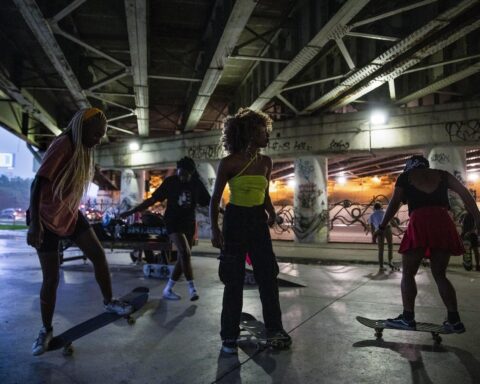Of the stories that Timuel Dixon Black Jr. told or relayed to generations that have come through the South Side of Chicago, his wife Zenobia Johnson-Black said he would often retell the tale of how his parents came to Chicago in 1919 to what is now the Bronzeville area when he was 8 months old, leaving Birmingham, Alabama.
“He looked around and noticed the injustice,” Johnson-Black recounted. “So he said to his mom, when he was 8 months old: ‘S—, I’m leaving this place!’ He took credit for bringing his parents up here because he didn’t know how to change his diaper, so his mother had to come and his daddy had to come to take care of his mama and him.”
At 102 years of age, Black died Wednesday, according to a family friend. Black’s wife said he entered hospice care Oct. 1.
During his time in Chicago, Black went on to become a teacher, writer, lecturer, decorated military veteran, archivist and the city’s unofficial chief historian who chronicled the evolution of Black life and culture. In his writings, lectures and appearances, he was able to describe with great detail what it was like to grow up during moments that became historically significant to the city’s identity.
“You have an individual who, because of the span of his life, his lived experience, both witnessed history, made history and wrote the history book,” said former Chicago Mayor Rahm Emanuel. “Not many people have that kind of breadth and depth. He put his thumb on the scale and tipped it. Because of the life he led and not only what he saw, but what he wrote, he made all our lives richer.”
Since 1919, Black walked the streets of Bronzeville (aka the Black Belt) and remained there except for a few interludes and during World War II, he wrote in his 2019 memoir, “Sacred Ground.” Black arrived in Chicago with the first wave of Blacks fleeing racial violence and discrimination in the South.
It’s in that telling of his arrival to Chicago as the youngest of three that Shermann “Dilla” Thomas (the Chicago Urban Historian, for those on TikTok) connected with Black.
“He always started his story like that because he wanted you to think about how bad the South must have been to come to Chicago at a time of the most violent race riot,” Thomas said. “The whole country knew about it. And still his family moved to Chicago without anything being resolved. The opening would always draw laughs, but when I told him I understood why he was telling that story, I could see him sit up and look at me; and that’s something I’ll never forget.”
Black’s grandparents were born enslaved. His father was a sharecropper who went on to work in steel mills first in the South and later in the Midwest. Black grew up seeing firsthand how restrictive housing covenants, racial wage gaps and discrimination in educational opportunities and jobs shaped segregation in the city and essentially created a Black underclass, but also gave birth to a unique, Black metropolis.
At first, his middle-class family lived in a small building at East 49th Street and South St. Lawrence Avenue, where they were the only Black family, he said in a taped interview produced for the Abraham Lincoln Presidential Library. But quickly, the building, block and entire community became home to only Blacks, he said.
In his writing and oral history projects, Black described not only the pain of living through segregation, but also the joys of living in a thriving Black community. Spurred by the circumstances, the Black community created its own taxi cab services called jitneys, established grocery stores and corner markets, and formed thriving schools and organizations, he said. Housing discrimination meant that even affluent Black families lived close to those who were struggling — creating symbiotic relationships where residents influenced one another and had social circles with people of varying means.
“It was a community of joy because there was so much hope. There was a friendship and kinship,” Black said in that interview.
Black graduated from DuSable High School in 1937 where he said he sat next to Nat King Cole before the crooner became famous. At school, he socialized with Dempsey Travis, who went on to become a Chicago real estate magnate, and John H. Johnson, who became a media mogul and millionaire. He considered playwright Lorraine Hansberry his younger sister.
When Black was 24, he was drafted into the military and shipped to Europe during World War II. In the Army, he traveled throughout England, Poland, France, Germany and other countries. He was awarded four bronze stars for his service (and a Croix de Guerre, a military honor accorded by France to noncitizens) but in 1945 he returned to Chicago where he was met with extreme prejudice and hostility.
“When I came back home, I went back to the same job that I had,” he said in an interview.
Seeing African Americans still struggling after serving in the military set Black on a path to fight for social justice and equity. At his mother’s urging, he enrolled at Roosevelt University and went on to get a master’s degree from the University of Chicago. After graduation, he started his career as a teacher.
First, Black taught at various schools in the city, including Roosevelt High School, Hyde Park High School, Farragut High School and his alma mater, DuSable. As an educator, he emerged as a leader and activist. He not only started organizations to mobilize Black residents to vote and attend protests, he was elected president of the teachers union.
In 1963, Black was tapped by A. Phillip Randolph to coordinate Chicago residents to participate in the March on Washington for Jobs and Freedom. That same year, he was among a group of Black candidates who ran for City Council to push against the city’s political guard. Black didn’t win but during his campaign he was quoted as saying it was time to “end plantation politics,” a phrase that drew national attention.
Three years after running for office, Black shifted his career focus from teaching in Chicago Public Schools to teaching at the college level, his records show. He worked as a dean with the City Colleges of Chicago and later as vice president for academic affairs at Olive Harvey College. In a controversial firing from City Colleges, Black drew widespread attention and that led to him being named director and chairman of community affairs for City Colleges, where he stayed until around 1975. When that administrative role was eliminated, Black went back to the classroom as a professor, a position he kept for another 14 years.
In the early 1980s, Black threw himself into registering voters and campaigning to help get the city’s first Black mayor, Harold Washington, elected. He is credited with helping to register 250,000 people to vote by visiting dozens of churches, block club meetings, restaurants, grocery stores, train stations, bus stops and other establishments.
“In that era and area, we organized politically, socially, economically because we had the base of power,” he said in a TV interview in 2012. “We felt a sense of responsibility to all.”
Black retired from City Colleges in 1989, but his work continued long after that. He lectured at nearly every college in the city and appeared as a keynote speaker at dozens of school programs.
In 2003, he wrote a book, “Bridges of Memory,” which was a compilation of interviews of Black residents who were part of the earliest migration to Chicago. He later published a companion book that examined the second wave of Black migrants. According to Susan Klonsky, friend and collaborator on Black’s “Sacred Ground” memoir, he intended to write a third book about the children of those who migrated from the South, but it did not reach fruition. All of his books were written longhand, with no computer, Klonsky said.
Black was in Chicago during the lynching and burial of Emmett Till, an event that helped spark the civil rights movement. He was in Chicago when Dr. Martin Luther King Jr. visited to draw attention to poverty and racism. He was in Chicago to watch the city elect Washington as its first Black mayor and when Barack Obama rose to the presidency.
He was a trusted adviser to Washington and Obama. Always, he was an ambassador for the city, which earned him the moniker “senior statesman of Chicago’s South Side.”
“Chicago, for my generation, was in fact sacred ground,” he said in a podcast interview with Emanuel in January 2018. “We loved the city in spite of the difficulties along racial lines that we had experienced. For me, and others like me in my generation, this has been a place that gave us the inspiration and opportunity to move ahead and break the barriers that existed.”
A jazz aficionado who said he started listening to that music when he was 5, Black worked to celebrate the art form and ensure its long-term preservation in the city. He was a longtime board member at the Jazz Institute of Chicago and helped organize its local jazz festivals. Today, the organization gives out a community service award bearing his name.
According to his wife, Black has received more than 10 honorary degrees and sat on more than 50 boards.
For decades, he was often called upon by journalists and authors to give a historical perspective to the city’s struggles and triumphs.
Black’s legacy is entrenched as evidenced in the thoughts of many members of the Chicago community, including those within the University of Chicago community, politicians, and groups like the Chicago Teacher’s Union.
Former President Obama said the city and the world lost an icon. “Over his 102 years, Tim was many things: a veteran, historian, author, educator, civil rights leader and humanitarian,” he said. “But above all, Tim was a testament to the power of place, and how the work we do to improve one community can end up reverberating through other neighborhoods and other cities, eventually changing the world.”
Eve Ewing, an author, sociologist, poet, playwright, former teacher and current assistant professor at the Crown Family School of Social Work at the University of Chicago, said Black was a hero of hers since she was a kid. “My heart is heavy, but I have no right to be sad because he has given us so much and is leaving behind all the tools we need: to love ourselves, to know our history, and to be good listeners and keepers of stories.”
Chicago Tribune columnist, radio host and author Rick Kogan was a big fan of both Black and Studs Terkel. “They just don’t make them like Tim and Studs anymore,” he said. “To have been fortunate enough to spend time with Tim Black and his old dear friend Studs Terkel was to be witness to vivid history lessons of Chicago, civil rights, social justice and everything else that should matter in this world. The two of them together were the living knowledgeable history of all that should be deemed good about Chicago, and life. They were like brothers of a splendid sort.”
Those sentiments were shared by Ida B. Wells’ great-granddaughter Michelle Duster. “Mr. Timuel Black embodied intelligence and achievement as well as humility and graciousness. Despite his awe-inspiring resume, he could be self-deprecating at times and had a good sense of humor about himself. Even though he was a trailblazer and firsthand witness to many history-making events, he gave others room to contribute and shine.”
Black touched those in the business world, including Andrea Zopp, managing partner at Cleveland Avenue, a privately held Chicago venture capital firm focused on the food and beverage industry. “Timuel Black’s legacy and impact are profound,” she said. “An accomplished historian and uniquely engaging storyteller, he was literally living history. His lived through incredible, powerful moments in Chicago’s history and shared his perspectives and thoughts in writings and speeches so that we could learn, be informed and be better.”
Black interviewed N’Digo publisher Hermene Hartman for both “Bridges of Memory” books. A friend of the family, Hartman said his life’s work is notable. Black’s work yielded many awards and honors, including University of Chicago’s William Benton Medal for Distinguished Public Service in 2012, honoring him as “one of the most influential civil rights leaders in Chicago history.” He was the first recipient of Chicago’s Champion of Freedom award in 2013 and the first honoree inducted into the Illinois Black Hall of Fame at Governors State University in March 2021. “He has been a stalwart in our community, meaning that every major event, every major person, every major activity, he’s been there,” Hartman said. “If he didn’t lead it, in charge of it, he was certainly a principal for and about issues involving social justice and equity in our community. That’s been his life’s work.”
A consummate and meticulous documenter, in 2010 Black donated all of his photographs, memorabilia, audiotapes, paperwork and other research materials to the Carter G. Woodson Regional Library’s Vivian G. Harsh Research Collection. At the time, his collection was the largest the library had ever assembled and it chronicled political, justice and labor movements in the city along with the history of jazz in Chicago.
Black married twice and had two children with his first wife. In addition to Johnson-Black, Black is survived by his daughter, Ermetra Black-Thomas. He was preceded in death by his son, Timuel Kerrigan Black.
Even as he aged, Black remained active in the community. Black would participate in giving tours of his beloved South Side, all the locales that held history for him. Through the University of Chicago’s Civic Knowledge Project, helmed by Bart Schultz, residents and tourists got to learn about Black working closely with King.
“If you’ve ever been on any tours … in which Tim is the tour guide on a bus and they go around and point out the churches that his parents belonged to and the places where great moments in the Civil Rights movement in Chicago occurred and where the labor unions that became fortresses in the labor movement were located, you kind of get the sense that he’s not kidding about sacred,” Klonsky said about Black’s Bronzeville.
“I have been consistently impressed by Timuel’s ability for growth; he’s not some historical figure trapped in another time,” said Schultz, who has partnered with Black on tours of the South Side for more than 21 years.
Black aggressively campaigned for the Obama Presidential Center to be brought to the South Side by writing and publishing letters of support in the Chicago Tribune, the Chicago Defender and other publications. Of his accomplishments, his wife of 40 years said he never met a cause he didn’t like, so much so that their mailbox was always full of thank-you notes and solicitations. And he contributed to them all — the Illinois Holocaust Museum, the DuSable Museum, the ACLU, Doctors Without Borders.
“In addition to the many known activities and events and operations and projects he’s been involved with, we were able to endow a scholarship, the Timuel D. Black Community Solidarity Scholar Fund at the University of Chicago, and he was quite proud of that,” Johnson-Black said.
“He always says to me, ‘I’ve done the best I could,’ ” Klonsky said. “‘I can rest easy.’ He doesn’t feel like he slacked off. I think that’s terribly important. Me and my husband came by the other day, visiting, and he said I’m counting on you young people to fix this mess. There is a sort of abiding optimism and hopefulness that doesn’t really leave him. I would say to him, aren’t you angry? Aren’t you depressed about this, especially when Trump got elected? He said no. ‘We just got to fix it. We made this mess, we just got to fix it.’ “
Former Chicago Tribune reporter Lolly Bowean contributed.







